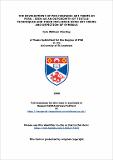Files in this item
The development of pre-Hispanic art forms in Peru : seen as an outgrowth of textile techniques and their influence upon art forms and depiction of symbols
Item metadata
| dc.contributor.advisor | Gifford, Douglas J. | |
| dc.contributor.author | MacKay, W. Iain | |
| dc.coverage.spatial | 405 p. | en_US |
| dc.date.accessioned | 2015-08-31T09:35:14Z | |
| dc.date.available | 2015-08-31T09:35:14Z | |
| dc.date.issued | 1988 | |
| dc.identifier | uk.bl.ethos.384562 | |
| dc.identifier.uri | https://hdl.handle.net/10023/7359 | |
| dc.description.abstract | Pre-Hispanic geometric art forms In Peru and the Andean Area are taken to be an outgrowth of textile techniques. Textiles and fibre arts predate ceramics by several millennia In the Central Andean Area. The artist who created these textiles developed an art style which was to go largely unaltered until the arrival of the Spaniards. The foundations of the Andean art form date to the Pre-ceramic. The restrictive, rather Inflexible nature of the warp and the weft of the cloth (the geometric grid) was to influence the methods of represention that were to follow. Geometric designs were well suited to fit Into the rigid framework. A series of conventions were developed for the representation of symbols. With the development of ceramics, there was leeway for a new style to come Into being. However, this was not to be the case. The potter borrowed extensively from the weaving tradition and Its associated styles (only in Moche times did the potter make a break the highly geometric style developed centuries before, and even then this break with tradition was a short lived one). The pre-Columbian artist often portrayed birds, cats, fish and reptiles. Many of these designs were used frequently and repeatedly throughout the centuries, but none, I would maintain. was represented as frequently as the double-headed serpent, and with so few variants. Andean art Is a truly distinctive art form; very different from European art, and through Its geometricity It conveyed and still conveys a totally different approach to nature and the world surrounding Andean man. | en_US |
| dc.language.iso | en | en_US |
| dc.publisher | University of St Andrews | |
| dc.subject | Peruvian textile | en_US |
| dc.subject | Textile | en_US |
| dc.subject | Fibers | en_US |
| dc.subject | Fabrics | en_US |
| dc.subject.lcc | F3429.3P8M2 | |
| dc.subject.lcc | Indian textile fabrics -- Peru. | en_US |
| dc.subject.lcc | Symbolism in art -- Peru. | en_US |
| dc.subject.lcsh | Textile design -- Peru. | en_US |
| dc.title | The development of pre-Hispanic art forms in Peru : seen as an outgrowth of textile techniques and their influence upon art forms and depiction of symbols | en_US |
| dc.type | Thesis | en_US |
| dc.type.qualificationlevel | Doctoral | en_US |
| dc.type.qualificationname | PhD Doctor of Philosophy | en_US |
| dc.publisher.institution | The University of St Andrews | en_US |
This item appears in the following Collection(s)
Items in the St Andrews Research Repository are protected by copyright, with all rights reserved, unless otherwise indicated.

